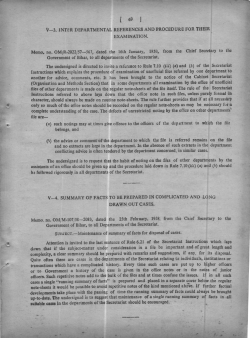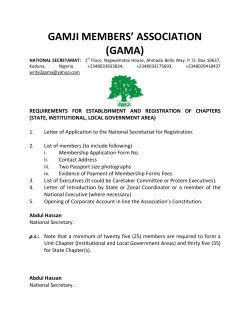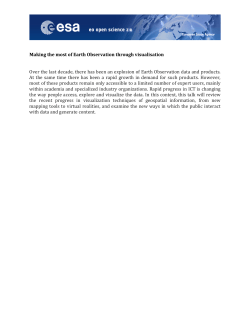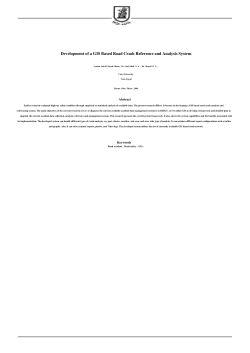
1 10 Map use at the United Nations
10 Map use at the United Nations Contributions from the United Nations 10.1 The Need of Maps in the United Nations This chapter show what functions maps have in the operations by the United Nations, for conflict prevention, food security, health campaigns, and humanitarian operations (See the diagram of the United Nations Family in figure 10.10). The United Nations has been producing and using maps since 1945 to support the needs of the United Nations Secretariat and the countries who are Member States. There were several offices in the United Nations Secretariat who produced maps or supported the mapping needs of all countries. 10.2 Cartographic Section In order to support the requirement by the United Nations Secretariat, there was one Cartographer in the Bureau of Documents of the Conference and General Services in 1946. By 1951, the need for maps increased in its importance in the United Nations and the Cartographic Unit was established in the Department of Conference Services with a team of cartographers. Today, the Cartographic Section of the Department of Field Support continues this tradition and practice and is responsible in providing the United Nations Secretariat different activities including (1) profile maps and deployment map production to be included in the official reports of the United Nations, (2) map clearance and guidance to United Nations Secretariat colleagues to ensure maps produced by the United Nations have one single cartographic practice, (3) provide map publication permission, (4) customized maps for the Security Council and United Nations Secretariat, (5) programme management of the Geographic Information Services (GIS) of field missions in peace operations, (6) technical assistance to Member States on international boundary issues, and (7) serving as joint Secretariat, together with the United Nations Statistics Division (UNSD) to the United Nations Committee of Experts on Global Geospatial Information Management (UN-GGIM). In order to provide more focused analysis and understanding of particular issues, the Cartographic Section has been involved in producing customized maps for United Nations Secretariat offices upon request. These maps vary in scope and theme but it allows the United Nations to communicate a message more clearly and effectively to the intended readers, whether it is the Security Council, countries for particular projects or the general public who are interested in the activities of the United Nations. Maps produced by the United Nations follow the principles of sovereignty and common cartographic practice. In order to ensure that the United Nations produces maps in a consistent manner in its official publications, the Cartographic Section is responsible to provide advice and guidance on maps produced by other offices in the United Nations. This service extends to the larger United Nations family. In order to have a better flow of information and collaboration amongst all United Nations family, specifically in the context of cartography, map production and use of geospatial information, experts from those organizations agreed in 2000 to establish a working group for coordination, sharing of data, products and knowledge. Named as United Nations Geographic Working Group (UNGIWG), it helps experts and their organizations collaborate more closely (http://www.ungiwg.org/). Many academics and organisations around the world use the maps produced by the United Nations for their publications. In order to ensure that copyright issues are cleared, the Cartographic Section also provides publication permission on behalf of the United Nations Publications Board. 1 Figure 10.1 Security Council session on Middle East. Source: UN Image Archive. 10.3 Peace Operations Maps have always been useful for the United Nations peacekeepers, since their earliest operations such as United Nations Truce Supervision Organization (UNTSO) in 1949, but their importance continued to increase as operations on the ground became more and more complex and challenging. Since 2000, the United Nations have been using GIS in the peace operation activities. Today, there are 12 United Nations peacekeeping or special political missions who map important information on the ground. These Geographic Information System (GIS) officers employed in the field missions provide different types of support depending on the mandate or the mission. Some field missions may require electoral support whilst others may require monitoring support and therefore some GIS offices will be preparing electoral maps including the collection of GPS location of polling centres or helicopter landing sites to transport the election ballots, whilst another GIS office would be preparing patrol maps for the military officers and observers to patrol a demilitarized zone. Figure 10.2. The United Nations Secretary-General inspects a field mission map. Source: UN Image Archive. A specific example of use of maps in the peacekeeping mission is that of MONUCSO, the United Nations Organization Stabilization Mission in the Democratic Republic of the Congo (DRC). The GIS office in MONUSCO plays a vital role in assisting MONUSCO and other United Nations family in achieving their goals efficiently and in a timely manner. The recent addition of Force Intervention Brigade (FIB) has added a new dimension to the umbrella of United Nations and posed new challenges and requirements. Previously, 1:50,000 topographic maps were the main reference for ground operations for patrolling, road recognizance survey and logistic transport. In troubled eastern DRC, analysing the threat and environment in a specific geographic area, became more important as FIB had to plan and conduct operations against armed groups. Therefore, the GIS office in MONUSCO generated 1:100,000 maps with greater area coverage allowing mission’s planners and peace keeping troops to have a better understanding of the region and battle field information for better planning. 10.4 The UN Map Collection Maps produced by the United Nations and maps collected for reference purposes were also collected by the UN Map Collection, co-located with the Cartographic Unit of the Department of Conference Services since its establishment. Today, the UN Reference Collection of the Department of Public Information, continues to take this responsibility to collect maps produced by the United Nations and also of countries for the use of the general public and for the diplomatic community (http://www.un.org/Depts/dhl/). 10.5 Regional Cartographic Conferences One can look back at the history of the Cartographic Section at the United Nations Secretariat Headquarters in New York City for a clearer picture. In order to support the external requirements in assisting Member States, the Cartographic Section of the Resources and Industrial Branch was first established following discussion on “The Question on cartography” by the United Nations Economic and Social Council (ECOSOC) in 1949. This office was responsible for the inter-governmental process amongst countries on cartographic issues including (1) preparation of reports and studies for ECOSOC in the field of cartography, (2) The International Map of the World on the Millionth Scale, (3) technical assistance administration to Member States, (4) publication of the annual bulletin 2 on World Cartography, and (5) organizing meetings related to cartography. Figure 10.3. A view from Dag Hammarskjöld Library. Source: UN Image Archive. The Statistics Division (UNSD) of the Department of Economic and Social Affairs continues to be the external face as an inter-governmental secretariat on cartographic issues in the United Nations Secretariat. The first United Nations Regional Cartographic Conference was organized in 1955 in the region of Asia and Pacific, followed by the region of Africa in 1963, and by the region of the Americas in 1976. These United Nations Regional Cartographic Conferences (http://unstats.un.org/UNSD/GEOINFO/RCC/) have continued to-date in their respective regions every three to four years. Today, there are two Regional Cartographic Conferences which convene for the region for Asia and Pacific (http://unstats.un.org/unsd/geoinfo/RCC/unrccap.html), and the Americas (http://unstats.un.org/unsd/geoinfo/RCC/unrcca.html). Initiative to reactivate the Regional Cartographic Conferences for the region of Africa is on the way, together with initiatives in the region of the Middle East and Europe. and disseminating standardized names (see also figure 10.4). 10.6 Geospatial Information as a global agenda A global initiative of bringing country’s national geospatial authorities together to play a leading role in setting the geospatial agenda has been taking place through the process of Global Geospatial Information Management (UN-GGIM). The GGIM process is the formal intergovernmental process through a Committee of Experts meeting which is held annually with the purpose to setting the agenda for the development of global spatial information and to promote its use to address key global challenges (http://ggim.un.org/default.html). 10.7 Ocean Affairs The Division for Ocean Affairs and the Law of the Sea of the Office of Legal Affairs serves as the Secretariat of the United Nations Convention on the Law of the Sea (UNCLOS) and provides information, advice and assistance to countries on law of the sea and ocean affairs. Countries are required to deposit with the Secretary-General of the United Nations, charts showing straight baselines and archipelagic baselines as well as the outer limits of the territorial sea, the exclusive economic zone and the continental shelf; alternatively, the lists of geographical coordinates of points, specifying the geodetic datum, may be deposited. The Division for Ocean Affairs and the Law of the Sea, has established facilities for the custody of those charts and lists of geographical coordinates. Geographical Names In 1959, ECOSOC recommended the establishment of the United Nations Conference on Standardization of Geographical Names (UNCSGN) (http://unstats.un.org/unsd/geoinfo/UNGEGN/ungegnCo nf10.html) and the United Nations Group of Experts on Geographical Names (UNGEGN) (http://unstats.un.org/unsd/geoinfo/UNGEGN/default.ht ml). Their activities focus on standardizing geographical names at the national and international levels, and todate, it is one of the seven standing expert bodies of the Economic and Social Council (ECOSOC). See also Chapter 8. The UNGEGN also organizes training courses and produces teaching material to help individual countries with collecting geographical names, creating databases 10.8 Other UN Secretariat Activities In addition to the above mentioned offices, a number of other Departments or Offices of the United Nations Secretariat decided to establish geospatial expertise within their area. Specific mandates and projects of those offices increased the need for such expertise to be immediately available to them. Below are brief descriptions of these other experts and their work, covering important areas such as maritime, safety and security, regional development and sustainability, humanitarian affairs and so on. Figure 10.4 Manuals for standardization of geographical names produced by UNGEGN. 3 Humanitarian Affairs Different parts of the world face different humanitarian crises every day whether it be natural or man-based causes, the United Nations Office for the Coordination of Humanitarian Affairs (OCHA) has been a crucial UN Secretariat office in bringing together humanitarian actors to ensure a coherent response to emergencies (http://unocha.org/). When disasters occur, one of the sites both the UN and non-UN humanitarian community refer to is OCHA’s information knowledge base of the Relief Web (http://reliefweb.int/), where disaster and crisis updates and analyses are brought together to allow the humanitarian community to make informed decisions and plan effective assistance. Whilst OCHA itself provides maps to show snapshots and hotspots, they also collate and disseminate maps prepared by other UN offices, agencies and non-governmental organisations which can be used in the field. One of the advantages OCHA has is the field level presence represented in over 50 country, regional and headquarters locations in the world where operational maps are also prepared by field based information officers trying to reflect the daily situation on the ground. Safety and Security The United Nations Department of Safety and Security (UNDSS) have a mandate to provide safety and security to personnel working in the United Nations offices and agencies around the world. UNDSS uses maps as a visualisation tool to assist in strategic and operational decision making. The data displayed on the maps is mostly internal confidential security information dealing with security levels of a particular area in a country, for example, an evacuation route planning to ensure safe passage of the UN staff. Drug and Crime prevention Some substantive offices of the United Nations Secretariat provide support to countries directly through their specific thematic mandate. Thematic maps are produced through these thematic mandates. One notable example is the activities by the United Nations Office on Drugs and Crime (UNODC), which deals with illicit drugs and international crime issues (http://www.unodc.org/unodc/index.html). This office uses satellite images and GIS analysis to produce maps on drug cultivation, drug production and trafficking. Analysis of geospatial data has also guided the implementation of alternative development programmes in areas affected by illicit crop cultivation. The yearly publication, World Drug Report, is an excellent example of how maps are used at UNODC. Maps at UNODC are also used to identify trafficking routes and to pinpoint strategic areas for organized crime. for its education statistics – from the number of children out of school to percentage of schools in Africa with access to electricity and drinking water. With such a rich array of data, the UIS is using maps to help people visualize trends in key areas (http://www.uis.unesco.org/Pages/interactive-contentarchive.aspx). For example, the UNESCO eAtlas series (http://www.uis.unesco.org/Education/Pages/unesco-eatlas-launch.aspx) presents interactive maps on a range of subjects – from girls’ education (see figure 10.5) to the resources devoted to research and development in more than 200 countries and territories. Flow maps let users track the origins and destinations of tertiary students pursuing their education abroad (http://www.uis.unesco.org/education/Pages/internation al-student-flow-viz.aspx). These are just a few examples of the ways in which the Institute is using maps to encourage people to use data to make a difference in the world. 10.9 Other UN Agencies The United Nations is a huge family of organisations, as mentioned above, and a lot of the needs by the countries cannot be accomplished by the United Nations Secretariat alone. Amongst the United Nations family, many United Nations Specialised Agencies also provide focused support to these countries through projects. Some of the main actors in this context are presented briefly below. UNESCO Outer Space Affairs The United Nations Office for Outer Space Affairs (UNOOSA) is responsible for promoting international cooperation in the peaceful uses of outer space. The UNESCO Institute for Statistics is the United Nations global repository for international statistics in the fields of education, science and technology, culture, and communication. The Institute is probably most famous 4 Figure 10.5 Girls’ enrollment in secondary education. Source: UNESCO. UNICEF The United Nations Children’s Fund (UNICEF) is mandated by the United Nations General Assembly to advocate for the protection of children's rights, to help meet their basic needs and to expand their opportunities to reach their full potential. UNICEF is active in more than 190 countries and territories through country programmes and National Committees. The maps created and provided by UNICEF aim to highlight its activities around the world. When UNICEF staff responds to an emergency in the field, maps become a very useful tool. These maps highlight UNICEF activities, service deliveries and our footprints during our response. Maps can vary, and can show where we are at a certain time and activities we are conducting; where is the highest percentage of undernourished children in the world; how many schools are in an area that UNICEF is managing, or the number of water distribution points or even locations of child friendly recreation centres. ESCAP and ITU developed countries have extensive fibre optic networks which allow fast and cheap Internet access, these networks tend to be less extensive in developing countries. Developing countries often rely on just one or two transoceanic fibre cables connecting them to the World Wide Web. Land locked countries use network of neighbouring countries, often at very high prices and as a result, the Internet in developing countries tends to be both more expensive, of lower capacity and more vulnerable to cable cuts. This hinders new opportunities offered by broadband internet, such as online jobs and education, or remote access to medical consultation services. In order to help redress this situation, the United Nations recently developed a set of maps that show the networks of land-based fibre optic cables. These maps are publically available online (http://www.itu.int/itu-d/tndmap-public/ ). See also figure 10.6. The information provided by these maps will help governments and the private sector to identify the missing links and bottlenecks in the current fibre optic networks. With appropriate investments, Internet should be made more secure from cable cuts, also bring increased competition and therefore lower prices in Internet access. The Economic and Social Commission of Asia and Pacific (ESCAP) which is a regional commission, and the International Telecommunication Union (ITU) which is a United Nations Specialised Agency for information and communication technologies have jointly worked to develop ESCAP/ITU Information Superhighway maps of fibre optic transmission networks. When we upload or download information from the Internet or send an email, this information travels through different types of networks. In most cases, long distance and high speed internet traffic takes place along fibre optic networks which criss-cross landmasses and oceans floors. While 5 Figure 10.6 Part of aESCAP/ITU map showing the network of land-based fibre optic cables. Source: ESCAP/ITU. The boundaries and names shown and the designations used on this map do not imply official endorsement or acceptance by the United Nations. FAO, WFP and UNEP The Food and Agriculture Organization (FAO) is a Specialised Agency focused on (1) eliminating hunger, food insecurity and malnutrition, (2) making agriculture, forestry and fisheries more productive and sustainable, (3) reducing rural poverty, (4) enabling inclusive and efficient agricultural and food systems and (5) increasing resilience of livelihoods from disasters. FAO’s GeoNetwork (www.fao.org/geonetwork/srv/en/main.home#) is a site where they collate geospatial information by FAO and its partners including United Nations family such as World Food Programme (WFP), United Nations Environment Programme (UNEP) and OCHA. damage caused by earthquakes human rights violations, water resources in remote areas, and many more are prepared within hours of an event. These products assist decision making of the senior management inside and outside the United Nations family. UNOSAT also researches new technological solutions such as collaborative mapping crowd sourcing, and the use of unmanned aerial systems (UAS). UNOSAT ultimately shares its know-how with countries by developing training and capacity development programmes. The United Nations Environment Programme (UNEP) is a Specialised Agency focusing on environmental issues. Their areas of focus are in (1) assessing global regional and national environmental conditions, (2) developing international and national environmental instruments and (3) strengthening institutions for management of the environment. UNDP and WHO WMO The United Nations Development Programme (UNDP) is a Specialised Agency which focuses on development issues for countries and focuses on (1) poverty reduction and achievement of the Millennium Development Goals, (2) Democratic Governance, (3) Crisis Prevention and Recovery and (4) Environment and Energy for Sustainable Development. They have different country based projects and in these specific projects, maps can be produced using GIS. The World Health Organisation (WHO) is a Specialised Agency which focuses on health issues in (1) promoting development, (2) fostering health security, (3) strengthening health systems, (4) harnessing research, information and evidence, (5) enhancing partnerships and (6) improving performance. WHO uses GIS to map different themes to communicate different health related issues (http://www.who.int/gho/map_gallery/en/ ).See also figure 10.7. Figure 10.7. The WHO map shows risks for droughts, flood and landslides in Guatemala based on data from 20082012.Source: WHO. UNOSAT The last decade has seen an important development in satellite imagery and space technology offering new perspectives and possibilities for the use of maps in the United Nations. To take full advantage of satellite imagery for mapping, the United Nations Institute for Training and Research (UNITAR), a research and training body of the United Nations family, created the Operational Satellite Applications Programme, known as UNOSAT in 2001. UNOSAT uses satellite imagery to generate geospatial information analysis to support the work of relief and development organisations inside and outside the United Nations family. UNOSAT turns publicly available satellite imagery into solutions to help make a difference in critical areas such as humanitarian relief, human rights, planning, and socio-economic development. Reports and maps of monitoring the extent of flood waters, assessing the 6 The World Meteorological Organization (WMO) is a Specialised Agency which focuses on the state and behaviour of the Earth’s atmosphere, its interaction with the oceans, the climate it produces and the resulting distribution of water resources (http://www.wmo.int/pages/about/index_en.html ). As the world’s climate continues to change, hazards to human health are increasing. The Atlas of Health and Climate (http://library.wmo.int/opac/index.php?lvl=notice_displa y&id=13572 ), published by the World Health Organization (WHO) and the World Meteorological Organization (WMO), illustrates some of the most pressing current and emerging challenges. Droughts, floods and cyclones affect the health of millions of people each year. Climate variability and extreme conditions such as floods can also trigger epidemics of diseases such as diarrhoea, malaria, dengue and meningitis, which cause death and suffering for many millions more. The Atlas gives practical examples of how the use of weather and climate information can protect public health. For example, in some locations the incidence of infectious diseases such as malaria, dengue, meningitis and cholera can vary by factors of more than 100 between seasons, and significantly between years, depending on weather and climate conditions (see figure 10.8) Figure 10.8. This temperature map shows the risk for getting malaria. Dark colour indicates high risk, red and yellow lower risk and grey very low risk. Source: WMO. The World Bank The World Bank Group is part of the United Nations family and focuses on (1) financial products and services and (2) Innovative Knowledge Sharing for the purpose to assist countries in their development. As other Specialised Agencies, the World Bank also has different country projects where GIS is used to map different thematic issues. The World Bank also yearly publishes the Atlas of Global Development, which also is available on-line as the World Bank eAtlas of Global Development (url is http://data.worldbank.org/atlas-global) with maps on thematically organized development indicators (see also figure 10.9). Figure 10.9 CO2 emissions, from the Millennium Goals section in the eAtlas of Global Development. Source: The World Bank. 10.10 Conclusion The chapter captured only some of the highlights in the context of map uses within the United Nations family. As the different activities tell, the work by the United Nations family is very diverse and therefore different United Nations offices use maps and geospatial information differently. However, what is common throughout their work is that these maps are to serve the common goal of the United Nations Charter to benefit the international community at large. 7 Figure 10.10. The UN Family. . Figure 10.10. The UN family. 8
© Copyright 2025









